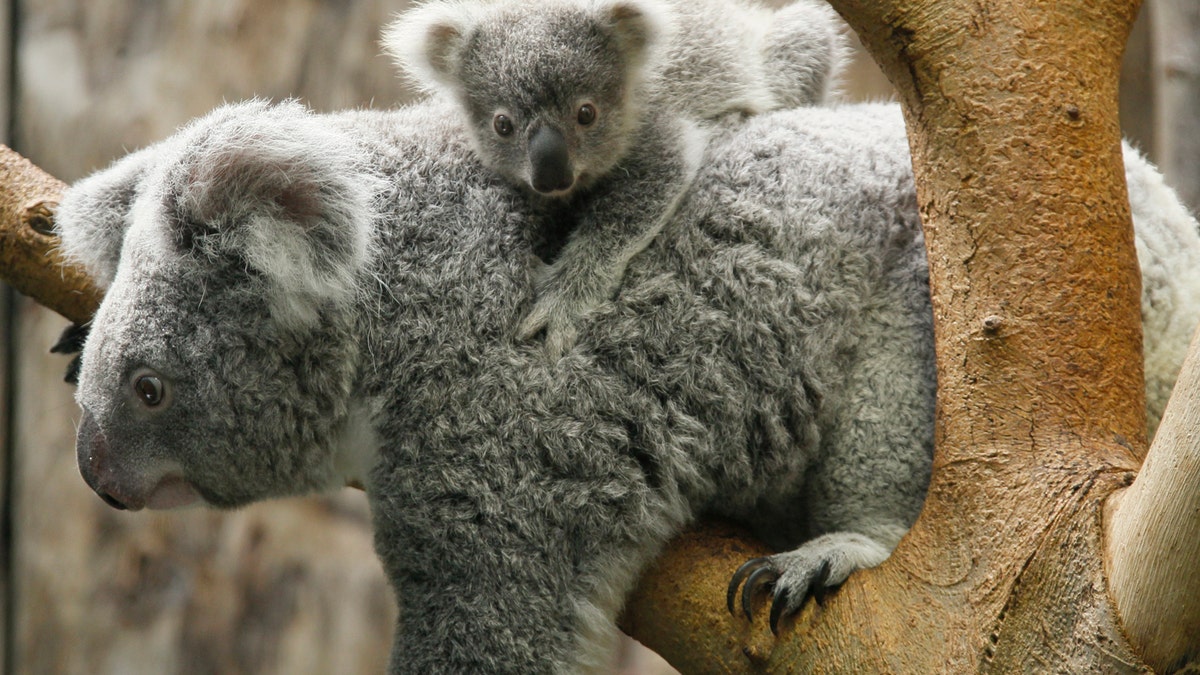
File photo: A koala joey hangs on its mother Goonderrah, the Aboriginal name for fighter, following a weighing procedure at the zoo in the western German city of Duisburg June 11, 2010. (REUTERS/Wolfgang Rattay)
They are a true Aussie icon, but there’s a lot more behind that cute koala munching on gum leaves — secrets that scientists didn’t have a definitive picture of until now.
In a world-first, researchers led by the Australian Museum and the University of Sydney have been able to uncover vital information on koalas and how their future depends on our protecting them.
Current studies predict koala populations could drop dramatically — as much as 50 per cent in the next 20 years in Queensland alone. And researchers say now is the time to make sure the much-loved marsupials don’t end up as the next Tasmanian devil.
Director of the Australian Museum Research Institute Professor Rebecca Johnson, who was joint leader of the koala study, said the reasons devils struggled was because they were not genetically diverse.
This genetic diversity was equally important when it came to koalas, according to the recent study.
Prof Johnson said that while you might see more koalas in South Australia, they were not as genetically important to the future of the species. That’s because when South Australia’s koala population was wiped out through hunting and populations were rebuilt, it led to them becoming inbred.
Meanwhile, koala populations in Queensland and NSW coastal areas are richer in diversity — but it is these populations that are most at risk.
The Australian Government lists koala populations in Queensland, NSW and the ACT as “vulnerable” under national environment law.
The comprehensive study — the best quality marsupial genome sequence to date — was undertaken in order to highlight the importance of conservation and the role genetic diversity plays within that.
Koala-related tourism alone is estimated to bring in more than $1.5 billion a year to Australia.
Scientists discovered how koalas tolerate a “toxic” diet of eucalyptus leaves, why they’re picky eaters, the benefits of mother’s milk for joeys, how they can develop or fight disease, their movements, evolutionary history and the effects land clearing has on them.
“It is a really important reminder that we cohabit with these animals and our backyards weren’t always there,” Professor Johnson said.
“They might be moving through your backyard because they want to find another tree or a mate and their genomes show they’ve been doing that for tens of thousands of years — and that’s really important to maintain.
“Obviously we have to conserve based on the landscape at the minute, and it’s tempting to think that it has never been any different, but the genome is a powerful way of capturing diversity and looking back to see what it once was.”
Professor Johnson said because we were increasing urbanizing koala habits, this could bring severe impacts.
“If you artificially chop them into smaller populations, that’s not great long-term,” she said.
“If you’re lucky to have a koala in your backyard, think about some measures to protect it like not letting it fall in your pool and your dog chasing it.”
The Australian-led consortium of scientists comprised 54 scientists from 29 different institutions across seven countries sequencing more than 3.4 billion base pairs and 26,000 genes in the koala genome.
This story originally appeared in news.com.au.
